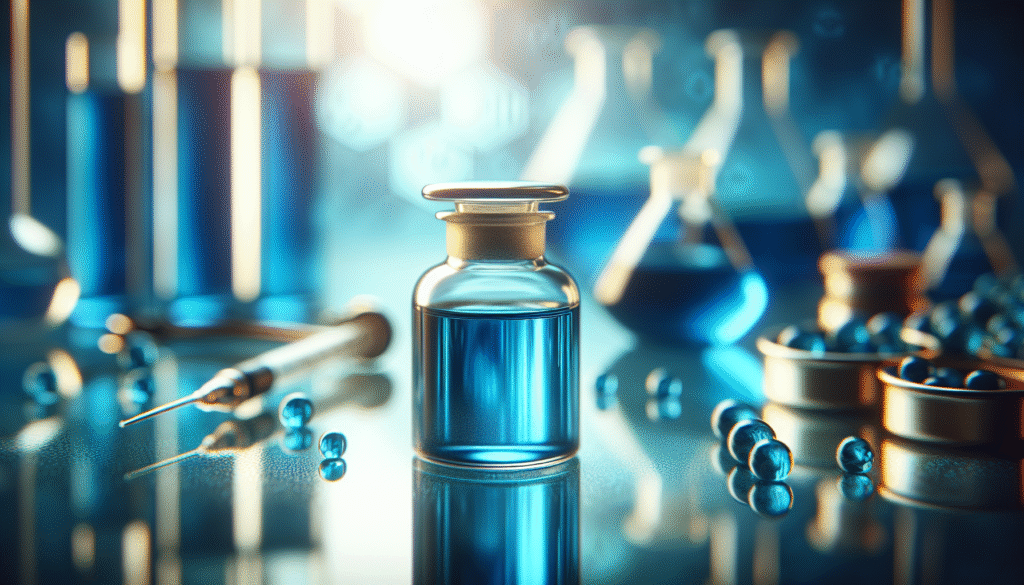
Have you ever considered the potential dangers associated with popular anti-aging treatments? Many individuals are continuously searching for ways to maintain their youthfulness, and one substance that has gained attention is Methylene Blue. While its use in various medical applications showcases its intriguing properties, the risks associated with using Methylene Blue for anti-aging purposes deserve a thorough examination.
Understanding Methylene Blue
Methylene Blue, initially synthesized in the 19th century, is a chemical compound that has been employed in many medical and scientific contexts. Originally used as a dye, it has transitioned into roles as a medication and a potential therapeutic agent for various conditions, including methemoglobinemia and certain infections.
In recent years, its potential for anti-aging has spurred interest, with some touting its benefits for enhancing cellular functions and mitochondrial health. However, before making any decisions about its use, it is essential to understand both its benefits and its associated risks.
The Science Behind Methylene Blue
Mechanism of Action
Methylene Blue works primarily by acting as an electron carrier, which enhances mitochondrial respiration. It is postulated to improve cellular energy metabolism and reduce oxidative stress—factors that contribute to aging. By facilitating the transfer of electrons in the mitochondria, Methylene Blue may help in maintaining cellular function and vitality over time.
Potential Benefits for Anti-Aging
While the research on Methylene Blue’s anti-aging properties is still in its infancy, some studies suggest that it may have benefits including:
-
Enhanced Cognitive Function: Preliminary studies indicate that Methylene Blue might improve memory and cognitive function, which can decline with age. Enhancing aspects of mental agility is appealing for those seeking to maintain mental acuity.
-
Improved Energy Levels: Users have reported increased energy levels, possibly due to improved mitochondrial function. This may create a sense of vitality that many seek to preserve as they age.
-
Skin Health: Some suggest that Methylene Blue can enhance skin cellular function, potentially helping to reduce signs of aging like wrinkles and fine lines.
Despite these potential advantages, prudent analysis of associated risks remains paramount.

Risks of Using Methylene Blue for Anti-Aging
General Safety Concerns
Before delving into specific risks related to anti-aging applications, it is crucial to address general safety concerns surrounding Methylene Blue:
-
Possible Allergic Reactions: Some individuals may experience allergic hypersensitivity to Methylene Blue. Symptoms can range from mild skin irritations to severe allergic reactions.
-
Drug Interactions: Methylene Blue can interfere with several medications. It is particularly dangerous with certain antidepressants, as it may precipitate serotonin syndrome—a potentially life-threatening condition.
-
Contraindications: Individuals with certain medical conditions, such as G6PD deficiency, should avoid Methylene Blue as it can induce hemolytic anemia.
Rare but Serious Risks
While many side effects associated with Methylene Blue are relatively mild, there are some rare but serious risks to consider:
-
Methemoglobinemia: Paradoxically, high doses of Methylene Blue can cause methemoglobinemia, a condition where hemoglobin is modified, diminishing its ability to release oxygen to tissues. This condition can lead to symptoms like cyanosis (bluish discoloration) and respiratory distress.
-
Neurotoxicity: Although uncommon, high doses can potentially result in neurotoxic effects, including neurological disorders. Careful dosing and supervision are necessary to mitigate this risk.
Specific Risk Factors Related to Anti-Aging Use
When considering Methylene Blue specifically for anti-aging purposes, several unique risk factors come into play:
-
Lack of Regulation: Methylene Blue is often sold as a supplement or unregulated product, which can lead to inconsistencies in purity and dosage. When using such products, the risk of consuming harmful contaminants or incorrect dosages increases.
-
Long-term Effects: There is insufficient research on the long-term effects of Methylene Blue use for anti-aging. This lack of data necessitates caution, as prolonged use can lead to unanticipated adverse effects.
Common Side Effects of Methylene Blue
It is essential to acknowledge the common side effects that can occur when using Methylene Blue, regardless of the intent:
| Side Effect | Description |
|---|---|
| Nausea | Some users experience gastrointestinal discomfort. |
| Headaches | Frequent headaches can occur as a reaction to the compound. |
| Dizziness | Users may feel lightheaded or dizzy, particularly at higher doses. |
| Skin Discoloration | Methylene Blue can temporarily stain skin and bodily fluids a blue color. |
Given these potential side effects, one must carefully weigh the benefits against the drawbacks before deciding to use Methylene Blue as an anti-aging treatment.
Safety Guidelines for Methylene Blue Use
To minimize risks while considering Methylene Blue as a means of combating the signs of aging, adhering to specific safety guidelines is imperative.
Consultation with Healthcare Professionals
One of the most critical steps is to consult with a healthcare professional before starting any new treatment. This consultation provides vital support in assessing individual health conditions, understanding potential drug interactions, and developing a safe usage plan.
Adhere to Recommended Doses
If you choose to use Methylene Blue, be diligent about adhering to the recommended dosages. High doses do not necessarily translate to better results and can increase the risk of adverse effects.
Monitor Yourself for Side Effects
Keep a close eye on how your body responds to Methylene Blue. If you notice unexpected side effects or adverse reactions, report them to a healthcare provider promptly.

Alternative Anti-Aging Strategies
While Methylene Blue occasionally captures interest for its potential anti-aging benefits, numerous alternatives are available that may provide similar results without the accompanying risks.
Healthy Lifestyle Choices
-
Nutrition: Emphasizing a diet rich in antioxidants, vitamins, and minerals promotes overall health. Foods such as fruits, vegetables, nuts, and fatty fish contribute significantly to skin health and may help mitigate signs of aging.
-
Exercise: Regular physical activity is vital for maintaining energy levels and cognitive function. It also enhances circulation, which can promote healthier skin.
-
Sleep: Prioritizing quality sleep is crucial for restoring cellular health. Sleep directly affects the body’s ability to repair and rejuvenate, with insufficient rest contributing to premature aging.
Skincare Products
-
Retinoids: These vitamin A derivatives have been proven effective in reducing wrinkles and fine lines. They promote cellular turnover and enhance collagen production.
-
Peptides: Small protein fragments that can stimulate collagen production and improve skin elasticity, peptides are a safe alternative with anti-aging properties.
-
Antioxidant Serums: These products, rich in vitamins C and E, help combat oxidative stress and protect the skin from environmental damage, providing a layer of defense against aging.
Mindfulness and Stress Reduction
Emotional health plays a critical role in the aging process. Incorporating mindfulness practices such as yoga, meditation, or deep-breathing exercises can reduce stress. Chronic stress can lead to premature aging, so managing it effectively contributes to longevity and a youthful appearance.
Conclusion
The quest for youthful vitality through anti-aging solutions can lead individuals toward promising but potentially risky treatments like Methylene Blue. While it may offer certain benefits, understanding the range of risks associated with its use is essential for making informed decisions. Consulting with healthcare professionals, adhering to recommended doses, and being vigilant regarding side effects can help mitigate risks.
Ultimately, while Methylene Blue holds a fascinating place in the realm of anti-aging, balancing safety with the pursuit of youthfulness is paramount. Embracing a holistic approach that incorporates healthy lifestyle choices, effective skincare products, and mindfulness may provide a safer and equally effective route toward maintaining a youthful vigor without the inherent risks posed by Methylene Blue. The journey to age gracefully should prioritize well-being above all.